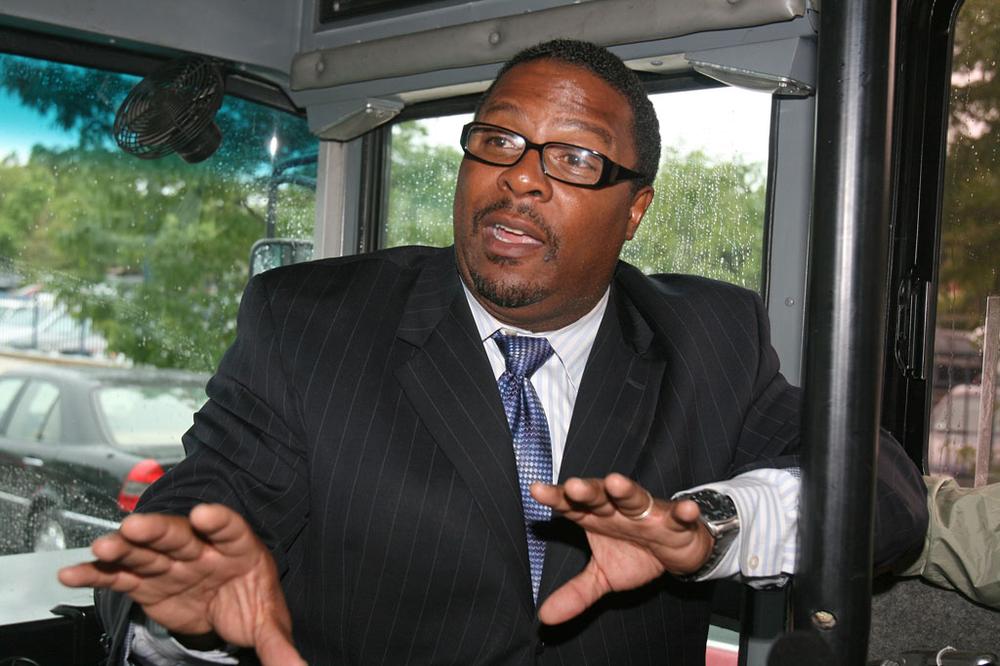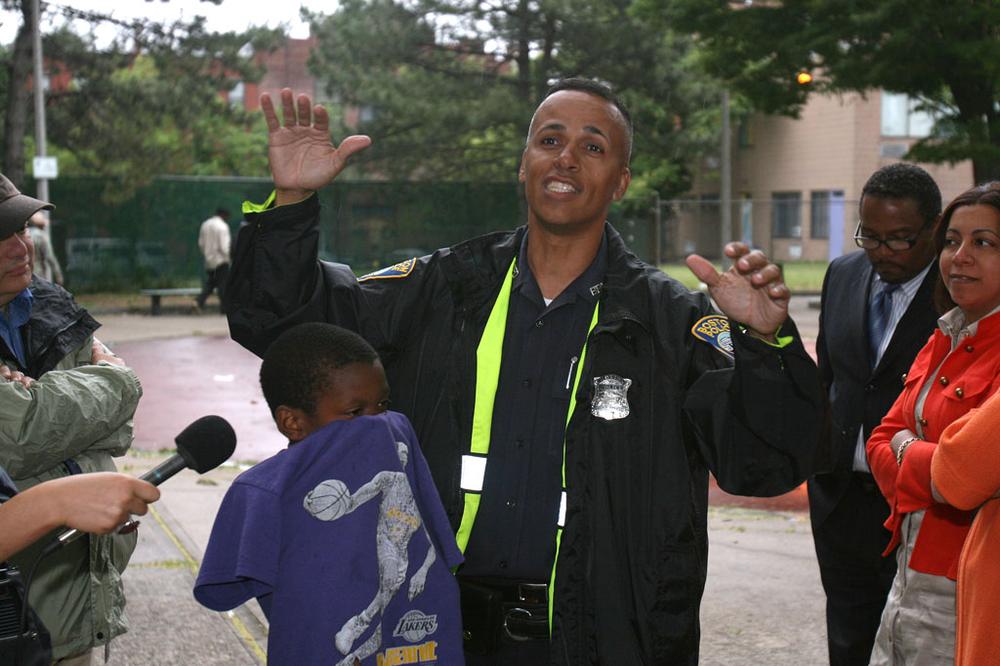Advertisement
A Small But Powerful Army On Boston's Most Violent Streets

Booming, aching song and prayer swelled through the overflowing pews of the small Timothy Baptist Church in Roxbury as hundreds gathered Tuesday afternoon to lay Simba Martin to rest — the day after the young man would have turned 22.
Martin was one of four victims gunned down last week in Mattapan, in what police believe was a drug-related massacre. A fifth victim remains hospitalized with a gunshot wound to the head. The neighborhood will on Wednesday mourn two more of those victims, Martin's girlfriend, Eyanna Flonory, 21, and her two-year-old son, Amani Smith, at the Morning Star Baptist Church.
It is the senseless killing of the toddler, Amani, that has left this community most in anguish, and sent waves of outrage throughout Boston. That outrage was audible in Mayor Thomas M. Menino's comments to the city on the day of the murders. "We will continue to take action on our impact players," the mayor said. "The mental health issues, anger and no regard for life. Their own or others."
The "impact players" the mayor talks about are the small percentage of young people in the city who are responsible for the vast majority of the violence on the streets. Identifying and targeting these players is one of Menino's goals in his battle against urban violence.

But it's the sole mission of a group of street workers, privately employed by the non-profit Boston Foundation, as part of the StreetSafe Boston initiative. The initiative was this week named one of the nation's "Bright Ideas" of 2010 by the Ash Center for Democratic Governance and Innovation at Harvard University's John F. Kennedy School.
StreetSafe is headed by Robert Lewis Jr. — Junior, to friends. Lewis talks passionately about the need to target this small group of high-risk young people, who he sometimes refers to as "shooters," meaning exactly what it sounds like.
"One percent of the 16-to-24-year-old population is responsible for 50 percent of the high-impact crime: murders, shootings and aggravated assaults," he says. "Eighty percent of the high-impact crimes happen in about one-and-a-half square miles of our city, the Blue Hill Avenue spine."
It is to this disproportionately violent stretch of Blue Hill Avenue that the StreetSafe initiative deploys its roughly 20 street workers. And it was just off Blue Hill Avenue, on Woolson Street in Mattapan, that police came upon the grisly murder scene last week. Not long ago, we spent an evening with Lewis, driving that one-and-a-half mile stretch of road.
Advertisement
When The Police Aren't Enough
We stopped first at O'Day Park in the South End, for a glimpse into the world many of the city's young people are growing up in. Officer George Diaz, of the Boston Police, met us on the pavement right next to an empty jungle gym. "Every day this situation gets worse," Diaz told us.
"Right now, this is actually calm, because the weather's a little dark," he said. "But if the weather wasn't dark, you'd see a couple of fights over here, you'd see somebody over there possibly smoking crack. You'd have to deal with all the gang members just to get into the park. Yesterday, as a matter of fact, we had five or six guys, looking to kill, sitting inside the playground right there that we had to toss out."
“I believe that there’s something instilled within us that guides us throughout this thing we call life.”
Arthur Kitty, street worker
O'Day Park is flanked on either side by big, brick housing developments. Diaz says the result is that the park often serves as a battleground for young people from the two sometimes warring projects. He doesn't sugarcoat the situation. Diaz seems youthful, with his lanky frame and baby face, but he's been working here as a community service police officer for 15 years — and it's taken its toll.
"I've developed anxiety over the years," he admits. "I take medication."
It is an unexpected revelation from an unconventional cop, one who says he feels as though he has failed whenever he uses his handcuffs.
"Every time that I put these on somebody," he says, holding them up, "all we're doing is admitting fault in the system. Because somewhere along the way, that child or that person asked for help, and somebody chose not to help them."
Which is why, the whole time Diaz is talking to us, he's got one arm around a 10-year-old boy who lives in one of the adjacent developments. He wants to get to the kid before anyone else does.
But Diaz, and the rest of the city's police officers, can't get to everyone. That's where the street workers come in. Of course, they can't get to everyone either. But the weapon they do have that most police don't is street cred. They come from the same neighborhoods as the young people they're working with, the impact players. So they're able to build trust in a way that few others could.
Leading By Bad Example
Our next stop is at the StreetSafe headquarters in Jamaica Plain, right next to the Bromley Heath housing development, and the worn old basketball court where Jaewon Martin was shot dead at 14 back in May. There, inside the headquarters, we're introduced to 16-year-old Dennis.
Dennis says he hasn't gotten into any trouble in awhile. But when he needs help, he comes to one of the street workers, Arthur Kitty.
"I been thinking I need to do something with my life," Dennis says. "So I'm gonna try to turn around to one of the street workers and he stood out more to me than anybody else was standing out because it was like we came from the same background."
Like most of the street workers, Kitty has a criminal record and has served time in prison. And so when he gives advice to this new generation of young people on the streets, he's speaking from some very real experience — experience he hopes he can keep them from going through for themselves. Kitty says, more than anything, he wishes he could give these young people the time to clear their heads.
"I know a lot of individuals who are incarcerated for life and wish that they could just take back 30 seconds," Kitty says. "And I always try to convey that to them: Thirty seconds, just buy yourself that. Just take your time. Whatever it is, just take your time, stop and buy yourself that moment."
Kitty also has faith in some inherent sense of right buried deep inside each of us. "I believe that there's something that is instilled within us that guides us throughout this thing we call life," he says. "Something told me not to do this, something told me not to do that. Listen to that voice when it first speaks to you. That's something that's embedded within you that hasn't been polluted by the world."
He pauses. "I implore them to listen to that voice," he says. "Listen to that gut feeling. Something's telling you don't go down that street. Don't go down that street."
Arthur Kitty, George Diaz and Robert Lewis Jr. all lament the fact that, every few days in Boston, a handful of young people still go down that wrong street, as someone did in Mattapan last week. The challenge now, they say, is creating opportunities and alternatives for the young people who are ready to go down a different street.
This program aired on October 6, 2010.